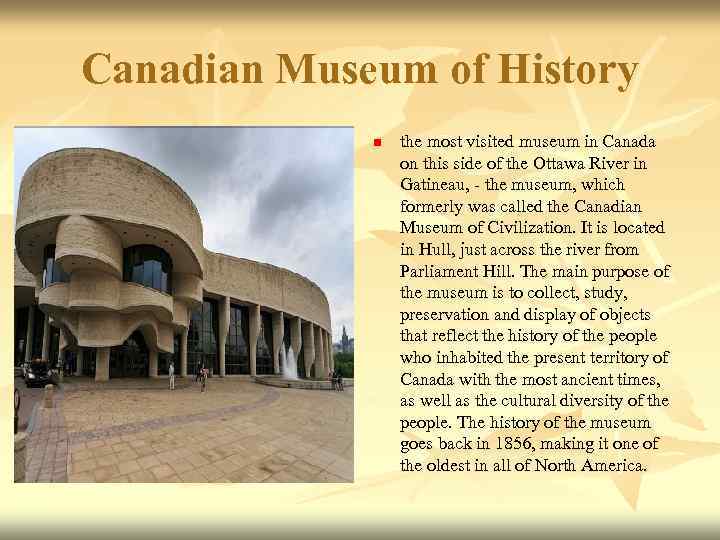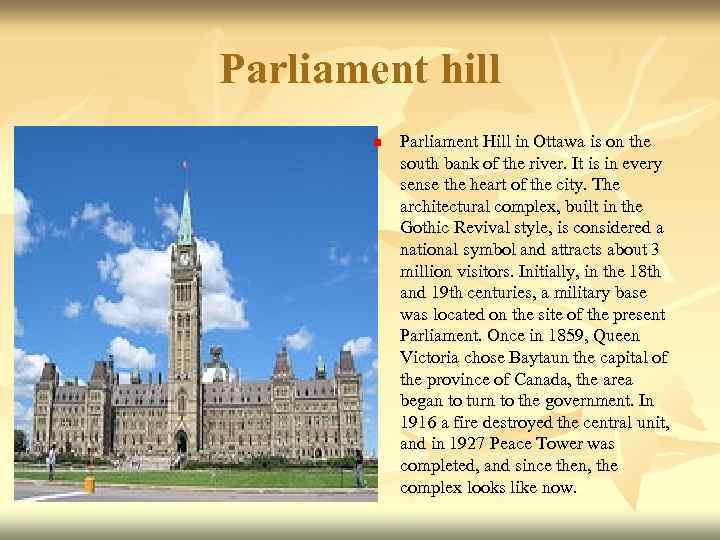 The Capital of Canada n Ottawa is the capital of Canada. One third of its people are Frenchspeaking. Ottawa is the capital of Canada and is located on the banks of the Ottawa, Rideau and Gatineau rivers. Canada’s fourth-largest city is a complementary blend of urban and rural lifestyles, old and new neighborhoods, culture and heritage, business and government. Ottawa also has a high standard of living reflected in a multitude of accessible services, vibrant entertainment, exciting recreational activities, and thriving businesses.
The Capital of Canada n Ottawa is the capital of Canada. One third of its people are Frenchspeaking. Ottawa is the capital of Canada and is located on the banks of the Ottawa, Rideau and Gatineau rivers. Canada’s fourth-largest city is a complementary blend of urban and rural lifestyles, old and new neighborhoods, culture and heritage, business and government. Ottawa also has a high standard of living reflected in a multitude of accessible services, vibrant entertainment, exciting recreational activities, and thriving businesses.
 n n Ottawa's population - 883 000 people, with Gatineau 1, 236, 000 (according to the 2011 Population Census). The city is administered by the municipal council headed by the mayor from December 1, 2010, he, Jim Watson. The city was founded in the 1820 s as a camp of soldiers and craftsmen who built the Rideau Canal, and in 1850 received the official status of the city and lesosplavschikov loggers. Until 1855 the city was named in honor of Lieutenant Colonel Baytaun John Bai, who led the work on the construction of the Rideau Canal. On December 31, 1857 Ottawa - the capital of the united Province of Canada, since 1867 - the capital of Canada state. In the future, the city developed as a transport and industrial center, and in the second half of the XX century has experienced a massive restructuring aimed at improving the urban environment.
n n Ottawa's population - 883 000 people, with Gatineau 1, 236, 000 (according to the 2011 Population Census). The city is administered by the municipal council headed by the mayor from December 1, 2010, he, Jim Watson. The city was founded in the 1820 s as a camp of soldiers and craftsmen who built the Rideau Canal, and in 1850 received the official status of the city and lesosplavschikov loggers. Until 1855 the city was named in honor of Lieutenant Colonel Baytaun John Bai, who led the work on the construction of the Rideau Canal. On December 31, 1857 Ottawa - the capital of the united Province of Canada, since 1867 - the capital of Canada state. In the future, the city developed as a transport and industrial center, and in the second half of the XX century has experienced a massive restructuring aimed at improving the urban environment.
 Air and Space Museum in Ottawa n The museum was established in 1964 on the basis of three collections: the National Aviation Museum in Aplends (early aviation), the Canadian War Museum (military aircraft and equipment) and the Museum of the Royal Canadian Air Force (most current models). In 1982 the museum was renamed and moved to experimental triangular building at the former hangar of World War II, where pilots were trained.
Air and Space Museum in Ottawa n The museum was established in 1964 on the basis of three collections: the National Aviation Museum in Aplends (early aviation), the Canadian War Museum (military aircraft and equipment) and the Museum of the Royal Canadian Air Force (most current models). In 1982 the museum was renamed and moved to experimental triangular building at the former hangar of World War II, where pilots were trained.
 Canadian Museum of History n the most visited museum in Canada on this side of the Ottawa River in Gatineau, - the museum, which formerly was called the Canadian Museum of Civilization. It is located in Hull, just across the river from Parliament Hill. The main purpose of the museum is to collect, study, preservation and display of objects that reflect the history of the people who inhabited the present territory of Canada with the most ancient times, as well as the cultural diversity of the people. The history of the museum goes back in 1856, making it one of the oldest in all of North America.
Canadian Museum of History n the most visited museum in Canada on this side of the Ottawa River in Gatineau, - the museum, which formerly was called the Canadian Museum of Civilization. It is located in Hull, just across the river from Parliament Hill. The main purpose of the museum is to collect, study, preservation and display of objects that reflect the history of the people who inhabited the present territory of Canada with the most ancient times, as well as the cultural diversity of the people. The history of the museum goes back in 1856, making it one of the oldest in all of North America.
 Parliament hill n Parliament Hill in Ottawa is on the south bank of the river. It is in every sense the heart of the city. The architectural complex, built in the Gothic Revival style, is considered a national symbol and attracts about 3 million visitors. Initially, in the 18 th and 19 th centuries, a military base was located on the site of the present Parliament. Once in 1859, Queen Victoria chose Baytaun the capital of the province of Canada, the area began to turn to the government. In 1916 a fire destroyed the central unit, and in 1927 Peace Tower was completed, and since then, the complex looks like now.
Parliament hill n Parliament Hill in Ottawa is on the south bank of the river. It is in every sense the heart of the city. The architectural complex, built in the Gothic Revival style, is considered a national symbol and attracts about 3 million visitors. Initially, in the 18 th and 19 th centuries, a military base was located on the site of the present Parliament. Once in 1859, Queen Victoria chose Baytaun the capital of the province of Canada, the area began to turn to the government. In 1916 a fire destroyed the central unit, and in 1927 Peace Tower was completed, and since then, the complex looks like now.
 Notre Dame n Dame Cathedral in Ottawa, built on the site of the wooden church of St. James. The Cathedral is located in the downtown area - the oldest and largest church in Ottawa. The first draft of the neoclassical cathedral was founded in 1841 and for three years was lined up for the lower tier of the church. But then we decided to change the design to the neo-Gothic, more popular at the time. Therefore, the final design is somewhat eclectic.
Notre Dame n Dame Cathedral in Ottawa, built on the site of the wooden church of St. James. The Cathedral is located in the downtown area - the oldest and largest church in Ottawa. The first draft of the neoclassical cathedral was founded in 1841 and for three years was lined up for the lower tier of the church. But then we decided to change the design to the neo-Gothic, more popular at the time. Therefore, the final design is somewhat eclectic.
 National Gallery of Canada n One of the most famous museums in Ottawa - National Gallery of Canada. Her building of glass and granite with octagonal towers were designed by renowned architect Moshe Safdie and built in 1988. It is true that many people at the time of the external inspection affects not so much the building itself, but what is in front of him. And this is neither more nor less than the nearly tenmetallic spider quite a spooky kind.
National Gallery of Canada n One of the most famous museums in Ottawa - National Gallery of Canada. Her building of glass and granite with octagonal towers were designed by renowned architect Moshe Safdie and built in 1988. It is true that many people at the time of the external inspection affects not so much the building itself, but what is in front of him. And this is neither more nor less than the nearly tenmetallic spider quite a spooky kind.


